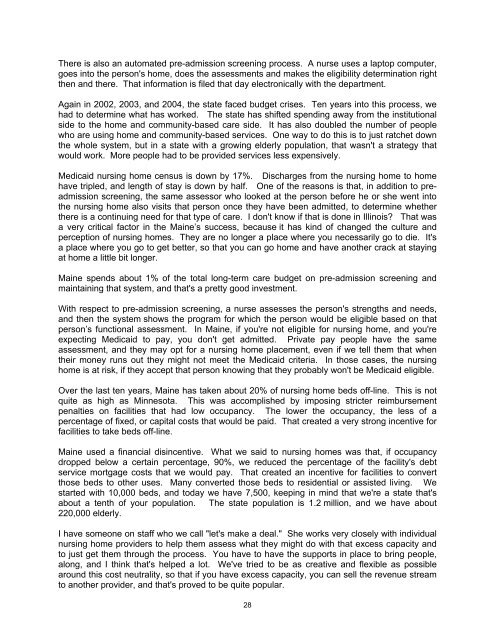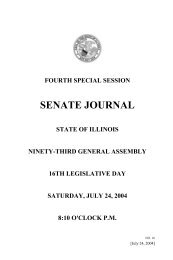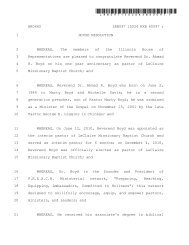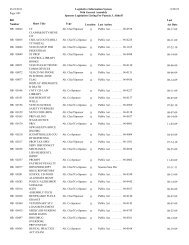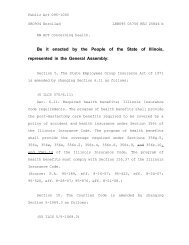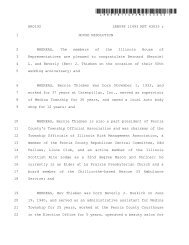Long-Term Care - Illinois General Assembly
Long-Term Care - Illinois General Assembly
Long-Term Care - Illinois General Assembly
Create successful ePaper yourself
Turn your PDF publications into a flip-book with our unique Google optimized e-Paper software.
There is also an automated pre-admission screening process. A nurse uses a laptop computer,<br />
goes into the person's home, does the assessments and makes the eligibility determination right<br />
then and there. That information is filed that day electronically with the department.<br />
Again in 2002, 2003, and 2004, the state faced budget crises. Ten years into this process, we<br />
had to determine what has worked. The state has shifted spending away from the institutional<br />
side to the home and community-based care side. It has also doubled the number of people<br />
who are using home and community-based services. One way to do this is to just ratchet down<br />
the whole system, but in a state with a growing elderly population, that wasn't a strategy that<br />
would work. More people had to be provided services less expensively.<br />
Medicaid nursing home census is down by 17%. Discharges from the nursing home to home<br />
have tripled, and length of stay is down by half. One of the reasons is that, in addition to preadmission<br />
screening, the same assessor who looked at the person before he or she went into<br />
the nursing home also visits that person once they have been admitted, to determine whether<br />
there is a continuing need for that type of care. I don't know if that is done in <strong>Illinois</strong>? That was<br />
a very critical factor in the Maine’s success, because it has kind of changed the culture and<br />
perception of nursing homes. They are no longer a place where you necessarily go to die. It's<br />
a place where you go to get better, so that you can go home and have another crack at staying<br />
at home a little bit longer.<br />
Maine spends about 1% of the total long-term care budget on pre-admission screening and<br />
maintaining that system, and that's a pretty good investment.<br />
With respect to pre-admission screening, a nurse assesses the person's strengths and needs,<br />
and then the system shows the program for which the person would be eligible based on that<br />
person’s functional assessment. In Maine, if you're not eligible for nursing home, and you're<br />
expecting Medicaid to pay, you don't get admitted. Private pay people have the same<br />
assessment, and they may opt for a nursing home placement, even if we tell them that when<br />
their money runs out they might not meet the Medicaid criteria. In those cases, the nursing<br />
home is at risk, if they accept that person knowing that they probably won't be Medicaid eligible.<br />
Over the last ten years, Maine has taken about 20% of nursing home beds off-line. This is not<br />
quite as high as Minnesota. This was accomplished by imposing stricter reimbursement<br />
penalties on facilities that had low occupancy. The lower the occupancy, the less of a<br />
percentage of fixed, or capital costs that would be paid. That created a very strong incentive for<br />
facilities to take beds off-line.<br />
Maine used a financial disincentive. What we said to nursing homes was that, if occupancy<br />
dropped below a certain percentage, 90%, we reduced the percentage of the facility's debt<br />
service mortgage costs that we would pay. That created an incentive for facilities to convert<br />
those beds to other uses. Many converted those beds to residential or assisted living. We<br />
started with 10,000 beds, and today we have 7,500, keeping in mind that we're a state that's<br />
about a tenth of your population. The state population is 1.2 million, and we have about<br />
220,000 elderly.<br />
I have someone on staff who we call "let's make a deal." She works very closely with individual<br />
nursing home providers to help them assess what they might do with that excess capacity and<br />
to just get them through the process. You have to have the supports in place to bring people,<br />
along, and I think that's helped a lot. We've tried to be as creative and flexible as possible<br />
around this cost neutrality, so that if you have excess capacity, you can sell the revenue stream<br />
to another provider, and that's proved to be quite popular.<br />
28


